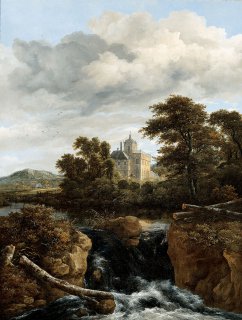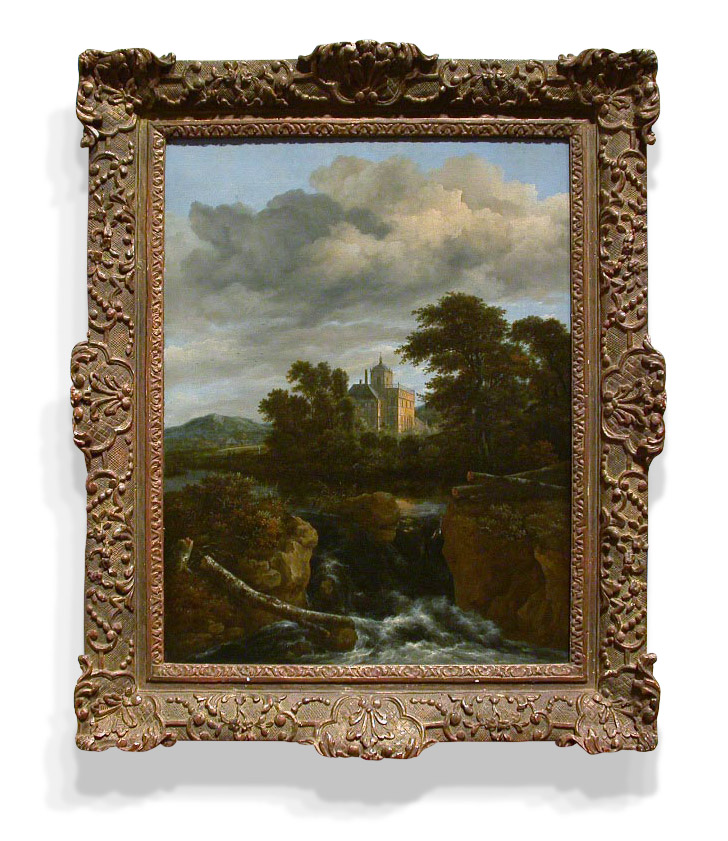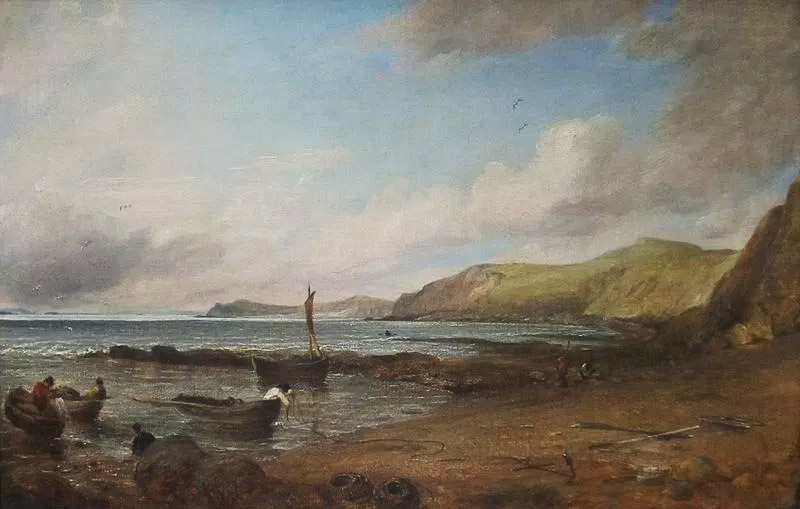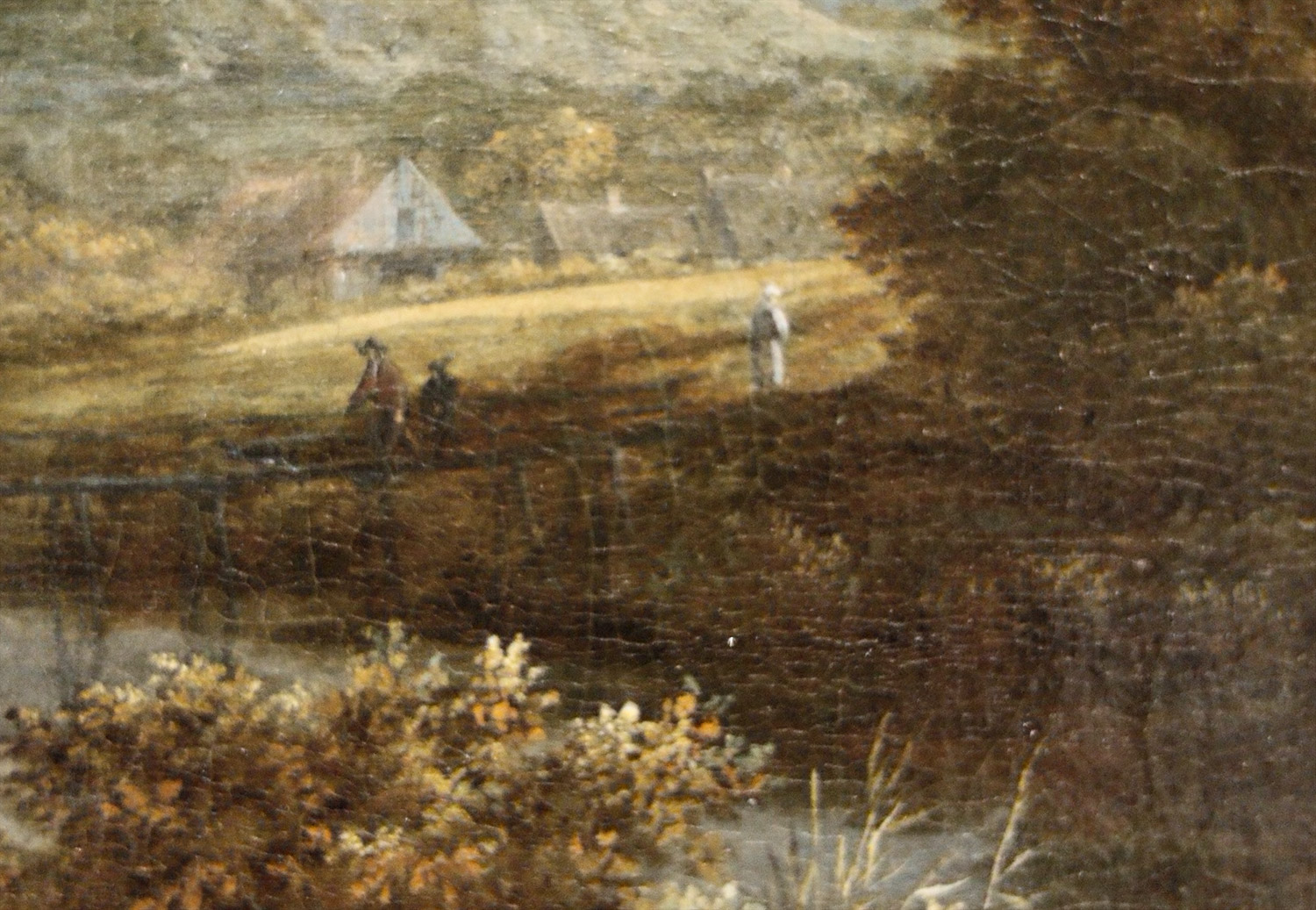
Jacob van Ruisdael
Landscape with Waterfall and Castle
(1628/29–1682)
Dutch c. 1670 Oil on canvas 27 ¾ x 21 ¾ inches Gift of the Arkaydia Foundation of the Rike-Kumler Company 1953.1
Transforming Nature
The sound of rushing water, a cool breeze, and a glowing evening sky: a Jacob van Ruisdael painting is a feast for the senses. Enjoy the view full of exquisite details, and then explore what else might be hidden in plain sight.
A Day in the Life
Social Structure
During the 1600s, the Dutch Republic thrived economically, particularly through industry and trade. There was also a huge appetite for paintings: millions were made during the century and people of all classes owned them. Artists depicted a wide range of subjects, leaving a detailed record of Dutch social life. Classes were largely distinguished by two factors: if one had disposable capital and if one did manual labor.
Even an apparently straightforward landscape painting such as this could veil class issues. The newly rich regents and merchants often attempted to imitate an aristocratic lifestyle, including building or buying country houses away from the noise and pollution of city life. Although this scene, including the building, is most likely a composite created by Ruisdael, it reflects current social aspirations for an idyllic retreat.
Further reading: Henk van Nierop, “The Anatomy of Society,” translated by Diane Webb, in Class Distinctions: Dutch Painting in the Age of Rembrandt and Vermeer, Ronni Baer (Boston: MFA Publications, 2015), 23–39.
Tools and Techniques
Behind the Scenes
What a Difference a Frame Makes
Look at the frame of the painting. In 2016, Landscape with Waterfall and Castle received a different frame. It is an original period frame made of ebonized pearwood, typical for Dutch paintings in the 1600s. During this time the Dutch heavily forested ebony wood from the colonized island of Mauritius off the east coast of Africa, and it was common to stain other woods to achieve a similar look. Frames like this complemented the dark and cool colors of Dutch paintings and fit with the restrained Protestant tastes of the time.
Previously, this painting was in an ornate gold frame more fitting for art from France. You can see a photo of what it looked like below.
Poll
Does having a painting in a frame from the period make it more important?

Look Closer
Just for Kids
Signs & Symbols
Dig Deeper
Arts Intersected
The Sculpture Speaks
Did You Know?
Expert Opinion
Look Around
Landscape Legacy
Ruisdael’s detailed and sensitive landscape paintings strongly influenced later artists. One in particular was the great English landscape painter John Constable (1776–1837); look for his painting Weymouth Bay in Gallery 213.
Constable admired the way Ruisdael really understood what he observed in nature and then translated into his art. To learn the secrets of the master, Constable made almost perfect copies of some of Ruisdael’s paintings and prints that he was able to see first-hand. By the end of his life he had even acquired a small collection of works by Ruisdael. Consider some of the ways you see Ruisdael’s influence in Weymouth Bay.

John Constable (British, 1776–1837), Weymouth Bay, 1824, oil on canvas, 14 ½ x 21 ½ inches. Lent by the Harold W. and Mary Louise Shaw Foundation, L61.2005.3.
Further reading: Seymour Slive, “Constable and Ruisdael,” in Jacob van Ruisdael: Master of Landscape (London: Royal Academy of Arts, 2005), 29–35.
About the Artist
Lover of Landscape
Jacob van Ruisdael is one of the great painters from the Golden Age of Dutch art during the 1600s, which included other famous names such as Rembrandt and Vermeer. Ruisdael specialized in landscape painting and helped make it a respectable subject for a serious artist; before this landscapes were only a backdrop for a historical or religious painting.
Quiz
Can you guess which of the following is true about Ruisdael?
He a painted a wide variety of landscapes.
He always painted outdoors.
He only made 11 paintings with waterfalls.
He carefully dated every painting he made and kept detailed journals about all the places he visited and painted.
Further reading: Seymour Slive, “Jacob van Ruisdael: Master Landscapist,” in Jacob van Ruisdael: Master of Landscape (London: Royal Academy of Arts, 2005).
Talk Back
A Moral Message?
During the 1600s, Protestantism strongly influenced Dutch art. It largely prohibited visual art in churches, and artists turned from religious subjects to scenes of everyday life, portraits of the emerging merchant class, landscapes, and still life paintings full of flowers and food. But did religious sensibilities disappear from Dutch art?
Look closer at some of the details in this painting, such as the waterfall and the broken tree, the dark clouds and birds in the sky, or the evening sunset. Also, notice the bridge with people walking in two directions. Some scholars have interpreted elements like these in Dutch landscapes as reminders of the shortness and vanity of life, and the need to journey to salvation. Read this way, the painting may convey a sense of melancholy and hope. If the artist intended this, would it increase your appreciation of the painting? What other interpretations could you give to these details?

Further reading: Josua Bruyn, “Toward a Scriptural Reading of Seventeenth-Century Dutch Landscape Paintings,” in Masters of 17th-century Dutch Landscape Painting, Peter C. Sutton (Boston: Museum of Fine Arts, 1987), 84–103.

